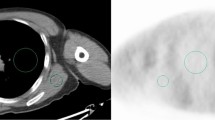Abstract
Purpose
Patient noise equivalent count (NEC), NEC density, and liver region of interest (ROI) S/N have been proposed as physical indicators of image quality, but have not been thoroughly compared with visual assessments. In this study, those indicators were contrasted with blind visual evaluations for whole-body fluorodeoxyglucose–positron emission tomography (FDG-PET) images acquired under a variety of scanning conditions and body weights.
Methods
Images were acquired on 15 normal subjects using a SET-3000B/L PET scanner with a continuous bed motion. Body weight ranged from 50.2 to 95.7 kg, with injected activity ranging from 71 to 333 MBq (1.40 to 3.67 MBq/kg) and a scan duration from 10 to 30 min. Patient NEC (PNEC; counts/cm) was calculated as the NEC rate divided by bed speed. NEC density (counts/cm3) was defined as the PNEC divided by the cross-sectional area derived from transmission data. Both PNEC and NEC density were averaged from neck to abdomen. Liver S/N was obtained as the pixel mean/SD within the ROI. Blind reviews by 18 professionals were used to visually evaluate image quality.
Results
Average visual score correlated with liver S/N, PNEC, and NEC density, with a rank correlation coefficient of 0.81, 0.86, and 0.91, respectively (each p < 0.0003). The “acceptable” quality roughly corresponded to a liver S/N of 10, PNEC of 380 kcounts/cm, and NEC density of 550 counts/cm3 or more.
Conclusions
NEC density, representing count statistics per body volume, reflects the visual image quality assessment and may be utilized for quality control of whole-body FDG-PET images together with the liver ROI S/N ratio.




Similar content being viewed by others
References
Eberl S, Fulham MJ, Meikle SR, Watson CC (2004) Optimization of injected dose and scanning protocol for 3D whole-body PETCT studies. J Nucl Med 45:426P
Kinahan PE, Surti S, Badawi RD, Fakhri G El, Karp JS, Lewellen TK (2004) Effect of patient thickness on noise equivalent count rates for 2D and fully-3D whole-body PET imaging. J Nucl Med 45(5). Proceedings of the SNM 51 Annual Meeting No. 284
Watson CC, Casey ME, Bendriem B, Carney JP, Townsend DW, Eberl S (2005) Optimizing injected dose in clinical PET by accurately modeling the counting-rate response functions specific to individual patient scans. J Nucl Med 46(11):1825–1834
deKemp A, Caldwell CB, Famcombe TH, McKee BT, Wassenaar RW, Wells RG et al (2006) PET imaging standards and quality assurance for the multi-center trials of the Ontario Clinical Oncology Group. J Nucl Med 47(1):365P
Matsumoto K, Kitamura K, Mizuta T, Tanaka K, Yamamoto S, Sakamoto S et al (2006) Performance characteristics of a new 3-dimensional continuous emission and spiral transmission high-sensitivity and high-resolution PET camera evaluated with the NEMA NU2-2001 Standard. J Nucl Med 47:83–90
Kitamura K, Takahashi S, Tanaka A, Ishikawa A, Mizuta T, Tanaka K et al (2004) 3D continuous emission and spiral transmission scanning for high-throughput whole-body PET. IEEE NSS and MIC Conference Record
Tanaka E, Amo Y (1998) A Fourier rebinning algorithm incorporating spectral transfer efficiency for 3D PET. Phys Med Biol 43:739–746
Kitamura K, Mizuta T, Tanaka K, Amano M (2003) A weighted Fourier rebinning method with high-pass filtering for continuous 3D scanning with a large aperture PET scanner. J Nucl Med 44(5):271P
Tanaka E, Kudo H (2003) Subset-dependent relaxation in block-iterative algorithms for image reconstruction in emission tomography. Phys Med Biol 48:1405–1422
National Electrical Manufacturers Association (2001) NEMA Standards Publication NU 2-2001. Performance measurements of positron emission tomographs. National Electrical Manufacturers Association, Rosslyn, VA
Bendriem B, Townsend DW (1998) The theory and practice of 3D PET. Kluwer, The Netherlands
Cherry SR, Dahlbom M (2006) PET: physics, instrumentation, and scanners. Springer, New York
Badawi RD, Marsden PK, Cronin BF, Sutcliffe JL, Maisey MN (1996) Optimization of noise-equivalent count rates in 3D PET. Phys Med Biol 41:1755–1776
Juweid ME, Stroobants S, Hoekstra OS, Mottaghy FM, Dietlein M, Guermazi A et al (2007) Use of positron emission tomography for response assessment of lymphoma: consensus of the imaging subcommittee of international harmonization project in lymphoma. J Clin Oncol 25(5):571–578
Cheson BD, Pfistner B, Juweid ME, Gascoyne RD, Specht L, Horning SJ et al (2007) Revised response criteria for malignant lymphoma. J Clin Oncol 25(5):579–586
Acknowledgments
The authors wish to thank the staff of Morinomiya Clinic, Mitsubishi Kyoto Hospital, Hanwa Intelligent Medical Center, Medical Plaza Yakushi Nishinokyo, and Osaka City Air Terminal Medical Corporation Seijukai for their cooperation in the evaluation of visual scoring.
Author information
Authors and Affiliations
Corresponding author
Rights and permissions
About this article
Cite this article
Mizuta, T., Senda, M., Okamura, T. et al. NEC Density and Liver ROI S/N Ratio for Image Quality Control of Whole-Body FDG-PET Scans: Comparison with Visual Assessment. Mol Imaging Biol 11, 480–486 (2009). https://doi.org/10.1007/s11307-009-0214-3
Received:
Revised:
Accepted:
Published:
Issue Date:
DOI: https://doi.org/10.1007/s11307-009-0214-3




